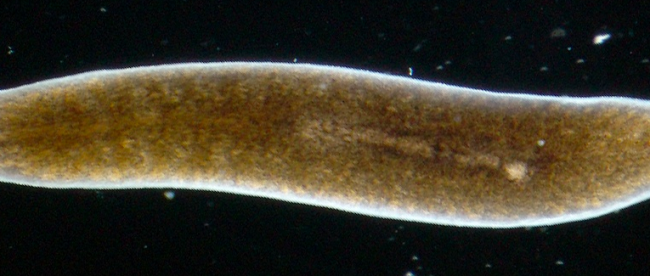When It’s OK to Lose Your Head

As a general rule, you don’t want to lose your head, especially not literally — it contains your eyes, ears, mouth, nose, and of course, your brain. And you kind of need those to survive. Keeping your head attached to your body is so critical to our survival that French revolutionaries famously developed an execution device, the guillotine, which had the sole premise of removing one’s heads from his or her body. Cutting off someone’s head is a really effective way to doom someone’s future.
Unless you’re one of these guys.

That’s a planarian, a type of flatworms. They’re tiny — only about an inch long, and at first glance they appear rather featureless. It isn’t even obvious that they have heads, but they do — it’s the left side of the image above, where those two little dots are that like kind of like cartoon eyes. Researcher Michael Levin, a professor of biology at the underrated Tufts University, explained to a school publication that these flatworms have a lot more brainpower than we’d think: “They have most of the same neurotransmitters we do. Their brains are very similar to our common ancestor.”
And Levin would know, because he and his Tufts colleague, biologist Tal Shomrat, have cut off a lot of the heads of these worms. For science, of course.
Worms can regenerate body parts, which is something that most curious (and perhaps slightly violent) young children discover on their own. And as it turns out, planarians, according to Radiolab, “can regrow its body parts better than almost any other animal on Earth.” Regrowing an “arm” (or whatever the flatworm equivalent is) seems different than regrowing a brain, though, right? Levin and Shomrat wondered the same, so they put it to the test. As Smithsonian succinctly summarizes, the pair “trained flatworms to travel across a rough surface [on a petri dish] to access food, then removed their heads.” (To be clear, the researchers removed the heads of the flatworms, not their own heads.)
About two weeks later, the once-decapitated flatworms regrew heads, as anticipated. But their new heads came with something not new: the old memories that, one would have expected, were lost with the previous head. Some worms were placed back in the petri dishes with rough surfaces; others were placed in a new tactile environment. Per the Tufts publication, “the worms that had been in the rough dishes immediately recognized the environment as safe and began eating right away, while the worms that had not been in that environment continued to take time to explore.” Somehow, the worms remembered what to do, even though they had literally lost their heads.
How this works is still unclear; while it’s very likely that planarians store their memories in places other than their heads, we’re not sure where nor how the recall function works. And whether we can adapt this trait for ourselves is, similarly, unknown.
Bonus fact: The guillotine is generally seen as an instrument from the French Revolution, but it has been used in France more recently. France used the guillotine for three executions in the 1970s, and only officially dropped the use of the guillotine when it outlawed the death penalty altogether in 1981.
From the Archives: Liquid Memories: When caterpillars turn into butterflies, they turn into goo along the way. And then they remember their pre-goo experiences.
